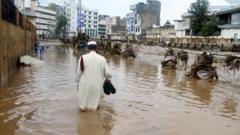The devastation has extended to Pakistan-administered Kashmir and the Gilgit-Baltistan region, where nine and five casualties were recorded, respectively. With heavy rain forecasted until August 21, several regions have been declared disaster zones. Eyewitness accounts highlight the intensity of the disaster, with locals describing the floods as apocalyptic. One survivor recounted, "I heard a loud noise as if the mountain was sliding... it felt like death was staring me in the face."
Khyber Pakhtunkhwa's chief minister confirmed that the M-17 helicopter had crashed due to adverse weather while en route to a rescue mission. Mourning has been declared across the province amidst sorrowful funeral gatherings.
On the other side of the Line of Control in Indian-administered Kashmir, emergency responders discovered bodies buried under mud after an avalanche of water swept through a village, resulting in approximately 60 more fatalities.
The monsoon season, which runs from June to September, is characterized by heavy rainfall, accounting for about 75% of annual precipitation in South Asia. This year, however, has been exceptionally severe, with reports stating that over 650 lives have been lost since the beginning of the season. In July, Punjab experienced a staggering 73% increase in rainfall compared to the previous year.
Experts suggest that climate change has been a major factor in intensifying weather patterns, leading to more frequent and devastating natural disasters. In northern Pakistan, glaciers are rapidly melting due to global warming, exacerbating flood risks and landslides. While the precise triggers for this latest flood disaster are still under investigation, glaciologists indicate that increasing ice melt may be a significant contributor to the current crisis.
Khyber Pakhtunkhwa's chief minister confirmed that the M-17 helicopter had crashed due to adverse weather while en route to a rescue mission. Mourning has been declared across the province amidst sorrowful funeral gatherings.
On the other side of the Line of Control in Indian-administered Kashmir, emergency responders discovered bodies buried under mud after an avalanche of water swept through a village, resulting in approximately 60 more fatalities.
The monsoon season, which runs from June to September, is characterized by heavy rainfall, accounting for about 75% of annual precipitation in South Asia. This year, however, has been exceptionally severe, with reports stating that over 650 lives have been lost since the beginning of the season. In July, Punjab experienced a staggering 73% increase in rainfall compared to the previous year.
Experts suggest that climate change has been a major factor in intensifying weather patterns, leading to more frequent and devastating natural disasters. In northern Pakistan, glaciers are rapidly melting due to global warming, exacerbating flood risks and landslides. While the precise triggers for this latest flood disaster are still under investigation, glaciologists indicate that increasing ice melt may be a significant contributor to the current crisis.






















